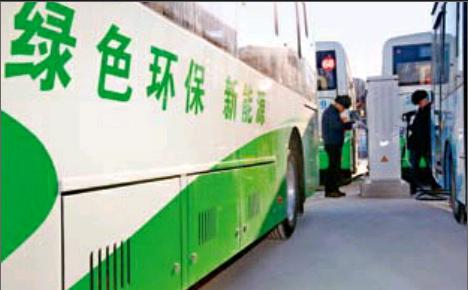Carbon Clipping
by+Luo+Jie


At the 2015 climate change confer- ence in Paris, China played an important role in achieving the Paris Agreement. At the opening ceremony of the conference, Chinese President Xi Jinping delivered a speech in which the country pledged to peak CO2 emissions by around 2030 and strive to begin curbing them as soon as possible. He pledged that by 2030, China would reduce CO2 per unit of GDP by 60-65 percent compared to 2005 levels, boost non-fossil fuel in primary energy consumption to about 20 percent and increase forest stock by around 4.5 billion cubic meters compared to 2005.
Actually, in its proposals for 13th FiveYear Plan (FYP) issued a month before the Paris conference, China clarified its guidelines for carbon reduction: Actively control carbon emissions, strengthen supervision of energy-extensive consumption industries, effectively control the carbon emissions of the industries such as power plants, steel, and building materials production, and push some areas to peak their carbon emissions before others, to introduce "nearzero" pilot programs in various regions.
Priority Job
United Nations Environment Program(UNEP) believes carbon dioxide is the primary culprit of climate change and environmental pollution. Over the past three decades, Chinas economy has achieved rapid development, but at a cost of rising carbon dioxide emissions. Thanks to increasing environmental awareness, emissions reduction has become the consensus of Chinese society.
In Chinas 13th FYP, the character for carbon, “碳”, is mentioned twelve times, evidencing that low carbon emissions have become a priority for the government.“Low carbon emissions or ‘near-zerorequire higher standards for Chinas devel- opment and have become key phrases in Chinas energy industry and even economic development during the countrys 13th FYP,” notes Xu Dingming of Chinas State Council and former head of the Energy Bureau at the National Development and Reform Commission.
“Compared to sulphur, saltpeter and dust, reaching ‘near-zero emissions for carbon is harder,” Xu emphasizes. “Now, many enterprises claim to be at ‘near-zeroemissions, but actually, they leave out the index for carbon emissions.” The 13th FYP has set targets and designated strategic measures for Chinas green growth. These policies are crucial to improving Chinas environment, according to Xu.
Economist Yang Weimin believes that to achieve carbon emission goals, the country should reduce carbon intensity while limiting the total volume of carbon emissions. Chinas energy-consuming industries like steel and coal production have shown excess production capacity, a condition that provides a good opportunity for cutting emissions. Also, the government should support areas like the Beijing-Tianjin-Hebei region, the Yangtze River Delta and the Pearl River Delta in reaching the emissions peak early, because in those areas, environmental capacity has reached its limit, and the production capacity of traditional industries has peaked.

4.1 Trillion RMB
Carbon reduction creates space for Chinas adjustment of its energy structures. For a long time, coal has been the primary energy resource in China, where consumption of coal hit 4.26 billion tons in 2014, accounting for a quarter of total world energy consumption. And Chinas coal consumption is more than half of the global total. The massive consumption of coal results in a heavy haze engulfing many Chinese cities during cold seasons.
Zeng Ming, professor at North China Electric Power University, notes that the country needs to adjust its mode and structure of energy consumption, which will serve as the main method to reduce carbon. In the short and medium-term, China must centralize power generation with coal to prevent scattered burning while reducing consumption by developing sustainable energies like wind, solar and nuclear.
According to Li Junfeng, director of the National Center for Climate Change Strategy and International Cooperation, to make non-fossil energy account for 20 percent of Chinas energy consumption within the next 16 years, Chinas non-fossil energy production needs to rise by 8.8 percent, which would be an increase of 800 million tons of non-fossil fuels and a reduction of 2 billion tons of carbon per year.
Li believes that in order to expand the usage of non-fossil energy, from 2016 to 2030, China needs to add nuclear power installed capacity of 0.1gw, hydropower capacity of 0.15gw, solar capacity of 0.3gw and wind power capacity of 0.4gw.
Xie Zhenhua, Chinas special representative on climate change, calculated that to achieve the reduction goal by 2030 using 2010 prices, China must spend 4.1 trillion yuan on adjusting energy structure, enhancing energy efficiency and developing new energy.
Market Means
The 13th FYP also highlights market mechanisms and energy system reform. Many economists consider carbon trading an important method to use the market to reduce carbon.
Carbon trading has been happening in developed countries for years. The government assigns a carbon quotient to different enterprises in various sectors. When one enterprise exceeds its carbon share, it must buy carbon emission volume from other companies that have minimized their outputs.
Since 2013, seven cities and provinces, including Shenzhen, Shanghai, Beijing, and Guangdong Province, have established pilot carbon trade markets. The total volume of carbon emissions in those areas of 1.2 billion tons is emitted by 2,000 enterprises, making it the second largest carbon trade system after only the European Union. The year 2017 will bring the launch of a unified carbon trade market nationwide.
The 13th FYP also proposes to set up pilot areas for "near-zero" emissions in hopes of accumulating experience. “To some degree, the period of the 13th FYP is a key phase for China to explore efficient ways to cut carbon discharges to achieve its preliminary emission goals,” explains Zeng Ming. “Based on its context and real situation, to reduce carbon emissions and achieve sustainable development, China needs to borrow experience from other countries and use both administrative and market means to raise environmental awareness and enthusiasm in both enterprises and the public.”

